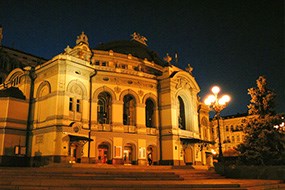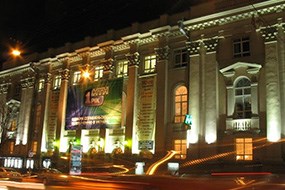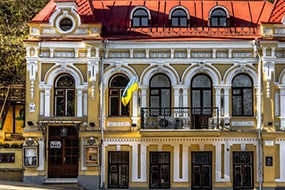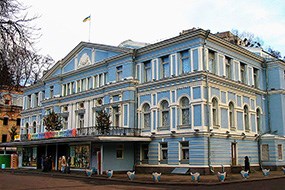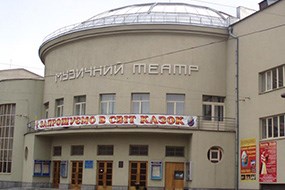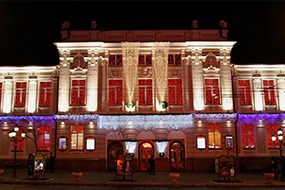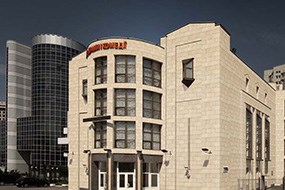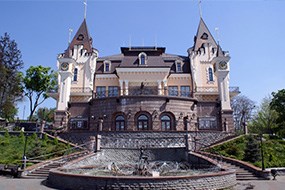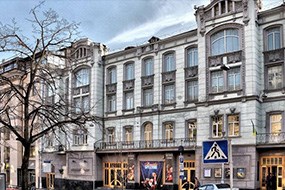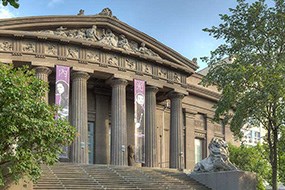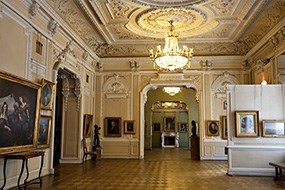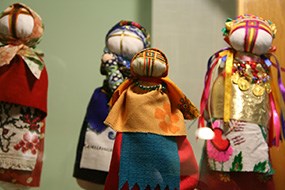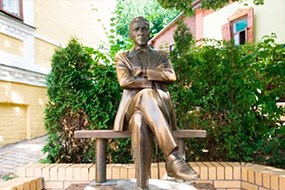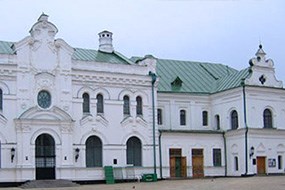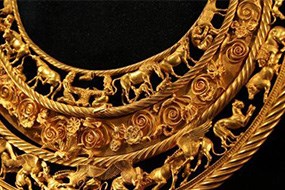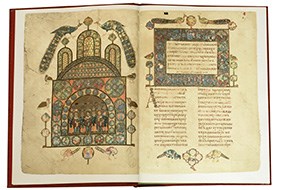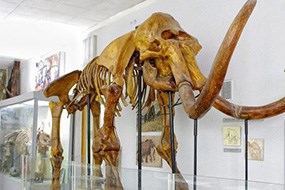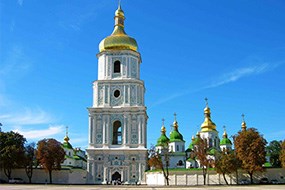
Sophia Cathedral
Saint Sophia Cathedral in Kiev is an outstanding architectural monument and one of the first examples of ancient Russian architecture. Today, it is one of the city's best known landmarks and the first Ukrainian patrimony to be inscribed on the World Heritage List. Originally the cathedral was a burial place of the Kievan rulers including Vladimir Monomakh, Vsevolod Yaroslavich and of course the Cathedral's founder Yaroslav the Wise, although only the latter's grave has survived.
The Cathedral has over 3000 meters of ornate ceiling paintings and more than 260 square meters of wall paintings and there is no place like it in the whole of Europe. On the inside, it retains mosaics and frescos from the eleventh century, including a dilapidated representation of Yaroslav's family and the Virgin Orans. Having been pillaged in the 12th century, the cathedral fell into disrepair until the 17th century when many more monasteries were added around the Cathedral in the Ukrainian Baroque style.
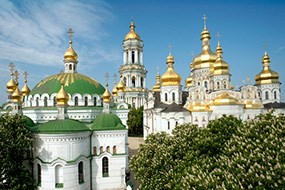
Kiev-Pechersl Lavra
Also known as the Kiev Monastery of the Caves, Kiev Pechersk Lavra is a historic Orthodox Christian monastery in Kiev. Construction started in 111 and continued for another 900 years and the Lavra has been a preeminent center of Eastern Orthodox Christianity in Eastern Europe since. Together with the Saint-Sophia Cathedral, it is inscribed as a UNESCO World Heritage Site. It was named one of the Seven Wonders of Ukraine on August 21, 2007.
According to the Primary Chronicle, in the early 11th century, Antony, a Greek Orthodox monk from Esphigmenon monastery on Mount Athos, returned to Rus' and settled in Kiev as a missionary of monastic tradition to Kievan Rus'. He chose a cave at the Berestov Mount that overlooked the Dnieper River and a community of disciples soon grew.
The word pechera means cave and the monks lived in these caves which can still be found all over the monasteries and even now, you can see the sites of their graves from darkened galleries under the ground. There are numerous architectural monuments here, Cathedrals, churches and museums to name a few. The main exposition contains articles from 16 to early 20th centuries which include chalices, crucifixes, and textiles from 16-19th centuries with needlework and embroidery of Ukrainian masters. The museum also provides tours to the catacombs, which contain mummified remains of Orthodox saints or their relics.
According to the Primary Chronicle, in the early 11th century, Antony, a Greek Orthodox monk from Esphigmenon monastery on Mount Athos, returned to Rus' and settled in Kiev as a missionary of monastic tradition to Kievan Rus'. He chose a cave at the Berestov Mount that overlooked the Dnieper River and a community of disciples soon grew.
The word pechera means cave and the monks lived in these caves which can still be found all over the monasteries and even now, you can see the sites of their graves from darkened galleries under the ground. There are numerous architectural monuments here, Cathedrals, churches and museums to name a few. The main exposition contains articles from 16 to early 20th centuries which include chalices, crucifixes, and textiles from 16-19th centuries with needlework and embroidery of Ukrainian masters. The museum also provides tours to the catacombs, which contain mummified remains of Orthodox saints or their relics.
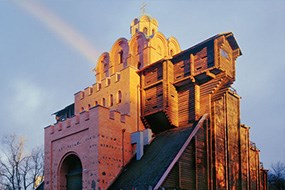
Golden Gate
The Golden Gate of Kiev is a historic gateway in the ancient city walls of Kiev. It is commonly known as Zoloti Vorota which is also used for a nearby theatre and a station of the Kiev Metro.
This gateway was one of three constructed by Yaroslav the Wise, Prince of Kiev, in the mid-eleventh century in order to protect the City. It was such an impressive fortress that enemies were kept away by the mere design and its’ magnitude. It remained as a gate to the city through the eighteenth century, although it gradually fell into ruins.
The structure was topped with a barbican church dedicated to the Deposition of the Virgin's Robe and today you can see theatre shows and plays in the adjoining museum depicting life in Kiev during these times.
This gateway was one of three constructed by Yaroslav the Wise, Prince of Kiev, in the mid-eleventh century in order to protect the City. It was such an impressive fortress that enemies were kept away by the mere design and its’ magnitude. It remained as a gate to the city through the eighteenth century, although it gradually fell into ruins.
The structure was topped with a barbican church dedicated to the Deposition of the Virgin's Robe and today you can see theatre shows and plays in the adjoining museum depicting life in Kiev during these times.
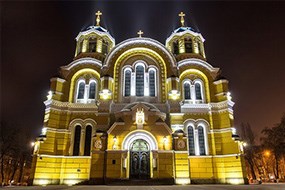
Vladimirsky Cathedral
St. Vladimirsky Cathedral, also known as the Vladimirsky Cathedral, or St. Vladimir's Cathedral is a cathedral in the centre of Kiev. It is one of the city's major landmarks and the mother cathedral of the Ukrainian Orthodox Church - Kiev Patriarchy, one of two major Ukrainian Orthodox Churches.
In 1852, metropolitan Philaret of Moscow suggested a large cathedral should be built in Kiev to commemorate the 900th anniversary of the baptism of Kievan Rus by Prince Vladimir (Volodymyr) the Great of Kiev (St. Vladimir). The design was executed in delightful Neo-Byzantine style initially by the architects I. Schtrom, P. Sparro, R. Bemhardt, K. Mayevsky, V. Nikolayev. The final version of the design belongs to A. Beretti. It is a traditional six-piered, three-apsed temple crowned by seven cupolas.
It is the cathedral's colourful interior that particularly strikes the eye. Mosaics were executed by masters from Venice: S. Kostenko, V. Kotarbinsky, M. Nesterov, M. Pymonenko, P. Swedomsky, V. Vasnetsov, M. Vrubel, V. Zamyraylo, and others. The painting of the Holy Mother of God by Vasnetsov in the altar apse of the cathedral is one of the world masterpieces of fine art.
In 1852, metropolitan Philaret of Moscow suggested a large cathedral should be built in Kiev to commemorate the 900th anniversary of the baptism of Kievan Rus by Prince Vladimir (Volodymyr) the Great of Kiev (St. Vladimir). The design was executed in delightful Neo-Byzantine style initially by the architects I. Schtrom, P. Sparro, R. Bemhardt, K. Mayevsky, V. Nikolayev. The final version of the design belongs to A. Beretti. It is a traditional six-piered, three-apsed temple crowned by seven cupolas.
It is the cathedral's colourful interior that particularly strikes the eye. Mosaics were executed by masters from Venice: S. Kostenko, V. Kotarbinsky, M. Nesterov, M. Pymonenko, P. Swedomsky, V. Vasnetsov, M. Vrubel, V. Zamyraylo, and others. The painting of the Holy Mother of God by Vasnetsov in the altar apse of the cathedral is one of the world masterpieces of fine art.
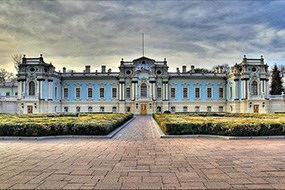
Mariinsky Palace
Situated in the government centre Mariinsky, (Tsar's) Palace was built in 1752 at the request of Empress Elizabeth and it was originally used for ceremonial and festive occasions. It was designed by Bartolommeo Francesco Rastrelli and constructed originally under the direction of Andrei Kvasov, who was later replaced by Piotr Neyelov. The palace ensemble includes gardens, greenhouses and a confectionary and the paths of the Mariinsky Park are perfectly designed to accompany the surrounding landscape. The palace was reconstructed in 1870, and is now used for government receptions.
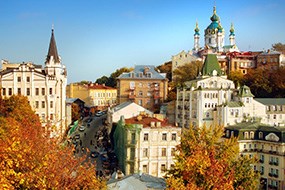
Andreevsky Descent
Andreevsky Descent in Kiev is regarded as the main road in much the same way as the Champs Elysee is in Paris. You will see many artists here selling handicrafts, jewellery, glass and ceramic works, wood carvings, toys, coins and much more. There are often street festivals and carnivals orchestrated by local actors and musicians which create an eclectic atmosphere for you to enjoy. The many bars and restaurants act as an oasis for the busy traveler to sit and relax while soaking up the unique environment of Kiev reminiscent of the late19th and early-20th century.
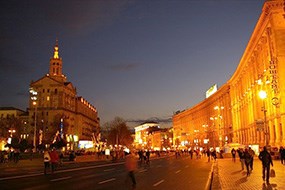
Khreschatyk Street
Khreschatyk is both a historical place and a busy shopping street. It connects Independence Square with Bessarabian Square and is blocked for traffic on weekends when you can enjoy a nice walk window shopping or relaxing in one of the many coffee bars along the way.
The entire street was completely destroyed during World War II by the retreating Red Army and rebuilt in the neo-classical style of post-war Stalinist architecture. Today, the street is the administrative and business center of the city, as well as a popular place for Kievans. You will find the Kiev City Hall here as well as the Philharmonic Concert Hall, Independence Square, cinema complexes, shops, hotels and restaurants.
The entire street was completely destroyed during World War II by the retreating Red Army and rebuilt in the neo-classical style of post-war Stalinist architecture. Today, the street is the administrative and business center of the city, as well as a popular place for Kievans. You will find the Kiev City Hall here as well as the Philharmonic Concert Hall, Independence Square, cinema complexes, shops, hotels and restaurants.
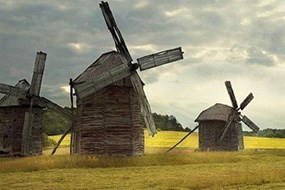
Open-air Museum Pirogovo
By far one of the most popular museums is located southwest of Kiev in the picturesque setting of the village of Pirogovo – the Museum of Ukrainian Folk Architecture, Rural Life, and Folk Art.
Stretching on the vast territory of 150 kilometers, this open air museum is divided into300 sites representing everyday life between the 17th and 20th centuries from every region of Ukraine.
The museum opened to the public in 1976 and to date has over 200 individual structures including wooden churches, a mainstay of the country’s ecclesiastical history, thatch cottages, farmsteads, and windmills.
The museum has over 40,000 ethnographic exhibits exhibited in the cottages, among which are folk costumes, fabrics, embroidery, carpets, ceramics, articles of metal, wood, glassware, musical instruments, paintings, tools and household articles.
Summer months bring entertainment as well as education when museum workers enact village roles, carving wood, throwing ceramic pots, and stitching intricate embroidery. Special craft festivals welcome blacksmiths, potters, coppers, weavers, carpet makers and other craftsmen of the present to demonstrate how the masters of the past created their masterpieces. Restaurants and food vendors sell Ukrainian food and musicians play traditional music on the weekend.
Stretching on the vast territory of 150 kilometers, this open air museum is divided into300 sites representing everyday life between the 17th and 20th centuries from every region of Ukraine.
The museum opened to the public in 1976 and to date has over 200 individual structures including wooden churches, a mainstay of the country’s ecclesiastical history, thatch cottages, farmsteads, and windmills.
The museum has over 40,000 ethnographic exhibits exhibited in the cottages, among which are folk costumes, fabrics, embroidery, carpets, ceramics, articles of metal, wood, glassware, musical instruments, paintings, tools and household articles.
Summer months bring entertainment as well as education when museum workers enact village roles, carving wood, throwing ceramic pots, and stitching intricate embroidery. Special craft festivals welcome blacksmiths, potters, coppers, weavers, carpet makers and other craftsmen of the present to demonstrate how the masters of the past created their masterpieces. Restaurants and food vendors sell Ukrainian food and musicians play traditional music on the weekend.
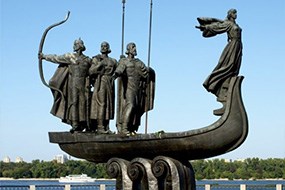
Dnieper Promenade
This is one of the favorite resting places of Kiev residents and tourists alike. Take a walk from Pachtovaya Square in the port area of Kiev to Paton Bridge where you will find the central station, and take the opportunity to enjoy a leisurely barge trip down the river. In the Square is the Church of the Nativity of Christ which was completed in May 1861 and this is where the people of Kiev said their goodbyes to the deceased T.G. Shevchenko. This promenade also houses the statues of the founders of Kiev. Legend speaks of a founder-family consisting of a Slavic tribe leader Kyi, the eldest, his brothers Schek and Khoriv, and also their sister Lybid, who founded the city. Kyiv/Kiev is translated as "belonging to Kyi".
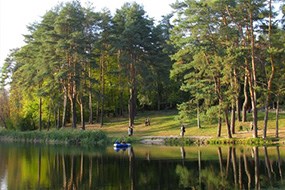
Goloseevsky National Park
This wonderful national park offers all you could wish for when contemplating a relaxing afternoon in Kiev. Within this truly magnificent forest you will find paths and nature walks with huge trees overhead providing welcome shade over the green fields and sparkling lakes. Take a picnic and a good book to really unwind, or visit one of the coffee shops along the lake to try our local brews and pastries.





